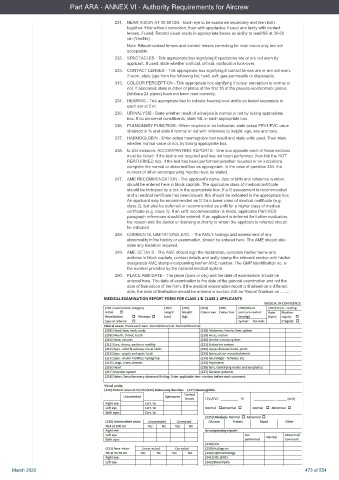Page 473 - UK AirCrew Regulations (Consolidated) March 2022
P. 473
Part ARA - ANNEX VI - Authority Requirements for Aircrew
231. NEAR VISION AT 30-50 CM. - Each eye to be examined separately and then both
together. First without correction, then with spectacles if used and lastly with contact
lenses, if used. Record visual acuity in appropriate boxes as ability to read N5 at 30-50
cm (Yes/No).
Note: Bifocal contact lenses and contact lenses correcting for near vision only are not
acceptable.
232. SPECTACLES - Tick appropriate box signifying if spectacles are or are not worn by
applicant. If used, state whether unifocal, bifocal, varifocal or look-over.
233. CONTACT LENSES - Tick appropriate box signifying if contact lenses are or are not worn.
If worn, state type from the following list; hard, soft, gas-permeable or disposable.
313. COLOUR PERCEPTION - Tick appropriate box signifying if colour perception is normal or
not. If abnormal; state number of plates of the first 15 of the pseudo-isochromatic plates
(Ishihara 24 plates) have not been read correctly.
234. HEARING - Tick appropriate box to indicate hearing level ability as tested separately in
each ear at 2 m.
235. URINALYSIS - State whether result of urinalysis is normal or not by ticking appropriate
box. If no abnormal constituents, state NIL in each appropriate box.
236. PULMONARY FUNCTION - When required or on indication, state actual FEV1/FVC value
obtained in % and state if normal or not with reference to height, age, sex and race.
237. HAEMOGLOBIN - Enter actual haemoglobin test result and state units used. Then state
whether normal value or not, by ticking appropriate box.
238. to 244 inclusive: ACCOMPANYING REPORTS - One box opposite each of these sections
must be ticked. If the test is not required and has not been performed, then tick the NOT
PERFORMED box. If the test has been performed (whether required or on indication)
complete the normal or abnormal box as appropriate. In the case of question 244, the
number of other accompanying reports must be stated.
247. AME RECOMMENDATION - The applicant’s name, date of birth and reference number,
should be entered here in block capitals. The applicable class of medical certificate
should be indicated by a tick in the appropriate box. If a fit assessment is recommended
and a medical certificate has been issued, this should be indicated in the appropriate box.
An applicant may be recommended as fit for a lower class of medical certificate (e.g.
class 2), but also be deferred or recommended as unfit for a higher class of medical
certificate (e.g. class 1). If an unfit recommendation is made, applicable Part-MED
paragraph references should be entered. If an applicant is deferred for further evaluation,
the reason and the doctor or licensing authority to whom the applicant is referred should
be indicated.
248. COMMENTS, LIMITATIONS, ETC. - The AME’s findings and assessment of any
abnormality in the history or examination, should be entered here. The AME should also
state any limitation required.
249. AME DETAILS - The AME should sign the declaration, complete his/her name and
address in block capitals, contact details and lastly stamp the relevant section with his/her
designated AME stamp incorporating his/her AME number. The GMP identification no. is
the number provided by the national medical system.
250. PLACE AND DATE - The place (town or city) and the date of examination should be
entered here. The date of examination is the date of the general examination and not the
date of finalisation of the form. If the medical examination report is finalised on a different
date, the date of finalisation should be entered in section 248 as ‘Report finalised on .......’.
March 2022 473 of 554

